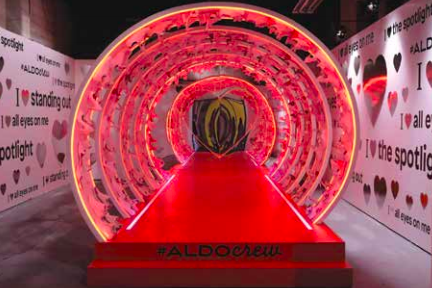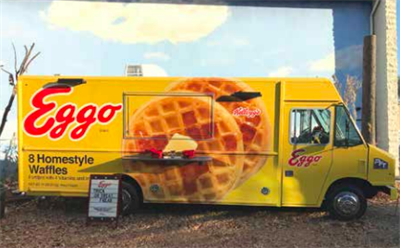The Rise of Experiential Marketing Agencies
Face-to-face events such as conferences and trade shows will always be an effective way for marketers to communicate directly with customers. But experiential marketing is different. It’s a multi-media form of B2C marketing that is specifically designed to spark an emotional response and generate online exposure well beyond the actual event.
Experiential marketing often blends digital, video and printed communications to immerse consumers in memorable live experiences that they will eagerly share on social media. In a report, “The Advertising Playbook: A Field Guide to Creating High-Reach Experiences,” Pier Fawkes says, “Experiential marketing has become the most critical tool in the modern marketer’s weapon chest.” Interactive brand-building engagements such as pop-ups and takeovers can spread exponentially, and their success can be tracked in detail. In a blog post on Chief Marketer, Bruce Henderson, Chief Creative Officer of Jack Morton Worldwide, discusses the differences between brand experiences, events and experiential activations.
Brand experiences can include a range of activities, including experiential stunts, corporate events, brand apps and in-store or call center employee/ consumer interactions. Effective brand experiences are designed to create specific, valuable interactions with the people that matter most to the brand.
Brand events include meetings, trade shows and conferences geared for participants with common interests.
Experiential activations are consumer-oriented experiences that create physical and emotional engagement with a brand or product and are designed to generate mentions in the press and on social media. They enable brands to establish digital connections with the people who participated in the physical experience. The ANA regards “brand activation marketing” as “the convergence of media platforms and channels to shape the way consumers experience brands.” The goal is to bring a brand to life and drive results through consumer behavior and/ or actions. According to a 2016 forecast produced by the ANA and PQ Media, spending on brand activation marketing is expected to reach $740 billion by 2020.

Some experiential activations are conducted through sponsorships that associate the brand’s product with the equity of another brand. This photo shows one of the rooms that the Aldo footwear and accessories company sponsored in the “29 Rooms” event conducted by Refinery 29 during New York Fashion Week. Refinery 29 is a women-focused digital media and entertainment company that reaches a global audience of 550 million across all platforms. The 29 Rooms event is an immersive exhibition of style, culture and technology designed to support the new era of live social storytelling. This year’s theme, “Turn It into Art,” celebrated the transformative power of creativity, and Aldo’s room, “Love Walk,” invited guests to step up to boldly pursue their passions and celebrate individuality and personal style. (Image courtesy of PRNewsfoto/Aldo.)
How PSPs Are Responding
Many commercial printers that specialized in the production and mailing of catalogs, direct mail and periodicals have already rebranded themselves as marketing services providers. Some began by offering assistance with personalized, variable data marketing campaigns for print and online communications. Others offered assistance with website design. Some printing companies merged with creative services firms that specialized in graphic design and online marketing. St. Joseph Communications in Toronto started out 50 years ago as a printing company and has become much more than a typical marketing services provider, promoting itself as “storytellers for the connected world.” St. Joseph Communications helps brands navigate the ‘omnichannel multiverse’ by connecting with audiences through the blending and blurring ecosystem of print and digital. To help brands efficiently create content for omnichannel distribution, St. Joseph Communications operates a content group, a media group and a print group. They offer support with creative services, photography and video production, content marketing, digital marketing, magazine publishing, package printing, in-store signage and more. In an eye-opening presentation at the Print 17 conference, St. Joseph Communications Chief Marketing Officer Michael Chase explained that brands have a different view of print in today’s fast-moving world of digital, mobile-first communications. Printed materials that are creatively designed and produced don’t have to be mass distributed if the print materials are unique enough to generate a lot of social media.
Listen to Your Customers
 Now that creative services for different marketing channels can be sourced anywhere, brands are looking for partners that can help make the complexity of delivering seamless customer experiences invisible.
Now that creative services for different marketing channels can be sourced anywhere, brands are looking for partners that can help make the complexity of delivering seamless customer experiences invisible.
Instead of hiring a lead ad agency, brands might rely on teams of companies that have expertise in specific disciplines (such as all types of digital printing). In a Verge article about “The Future Agency,” Kyle Chayka of the Tellart experience design agency said some agencies are now “paid to adapt unstable emerging technologies to marketing and branding efforts.” The right creative applications of emerging technologies in brand marketing can help normalize new technologies for mainstream audiences. As ad agencies, marketing firms, business consultancies and publishing companies continue to reshape their businesses, you should stay curious and respond to cues from your existing customers. For example, when Brandon Blair founded Cirrus Visual in Tucson, Arizona, 15 years ago, he had listened to enough customers of his uncle’s quickprint business to know that the shop visitors wanted more than ink on paper. They needed helped with the design and execution of their marketing concepts. (See sidebar on p. 30.) Here are some other points to consider: Don’t be surprised if agencies expect you to print things other than retail graphics or marketing collateral. If your company specializes in wide-format graphics, you’ve probably already noticed an uptick in demand for wayfinding signage, event graphics, vehicle wraps, backdrops, set designs and props related to brand activations. Designers of brand activations know that flatbed printers and other digital printing devices can be used to decorate almost any type of object they might want to create for an event. Once you understand how some of these one-of-akind pieces will be used, you might be able to suggest additional elements that your shop can create. Promote yourself as a solutions provider for experiential marketing or experience design. Network like crazy to make all types and sizes of creative services agencies aware of everything your printing firm can do. Give them dozens of ideas and examples of how your printed products can help make their next brand activation experience a huge success. Hire and retain talented designers and creative technologists. This may be easier said than done. If your printing company is having a tough time finding skilled employees, you’re not alone. A September 2017 report from the ANA revealed that many marketing and advertising agencies are facing a shortage of creative talent. The digital transformation of the advertising business has complicated the standard career paths offered by marketing and advertising agencies. Plus, marketing firms lack a common vision and vocabulary, and must overcome the perception that marketing careers aren’t relevant or meaningful. Many marketers and agencies now compete for creative talent with technology companies such as Google, Facebook and Apple and consultancies such as Accenture and Deloitte. If you have super-creative employees on your team, let them shine! Encourage your creative employees to learn more about experiential marketing and try crafting eye-opening printed pieces that are more artistic than promotional. Prepa re for ne w sou rc e s of competition. If ad agencies and printing firms are both looking to expand and diversify their services, some creative agencies may start offering their own short-run printing services. Bringing digital printing in-house enables them to explore different experiential marketing ideas from concept through prototyping and promotion. So, your firm should be prepared to offer high-value services that would be difficult for creative agencies to duplicate and aid in the final execution of the activation. This might include offering highly specialized finishing services, installing supersized graphics and wall murals, or 3D printing large, Instagram-worthy props. Keep abreast of what’s possible with interactive printed graphics. By attending events such as the SGIA Expo and PRINT United (launching in 2019), you and your creative team can stay upto-date with the latest technologies for printed electronics or connected print. If you don’t want to get into printed electronics yourself, you can network with partners who can assist you. Update your sales language. Study the websites of different types of advertising and marketing agencies. Update your own marketing copy to align with the types of services these agencies now provide their customers. For instance, instead of routinely talking about your skill in printing point-of-purchase graphics, maybe it’s time to talk about how you can print background graphics, décor elements and wraps that can support brand activations and other brand experiences. Take advantage of educational opportunities offered by printer manufacturers. Printer manufacturers such as HP, Canon and Ricoh are keenly aware of the marketing challenges facing big brands. And they are actively engaged in developing technologies and platforms that can make packages, graphics and printed materials serve as gateways to richer, more interactive experiences. If your current customers aren’t yet asking for interactive print, they could be soon. When designers attend brand activation events at festivals such as SXSW, videos and photos of creative applications of connected print can spread like wildfire on social media.